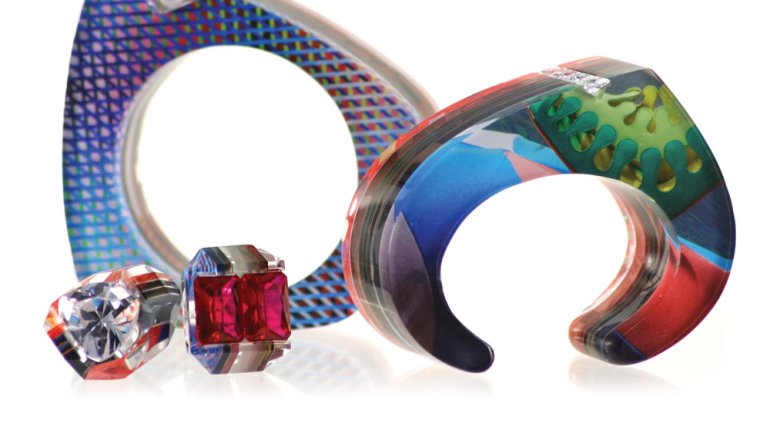The Next Big Thing
The Next Big Thing
“Acrylics and magazines, those are not the highest-end materials,” says Jennifer Merchant, a jewelry designer based in the Twin Cities. Yet with her fashionable, even high-end line of candy-colored jewelry, she has managed to craft something beautiful from these humble mediums.
Merchant’s work demonstrates that acrylic, a hard plastic, is surprisingly malleable. “You can carve with acrylic and work with acrylic just like you can with [metal] casting,” says the 29-year-old, who graduated from Georgia’s Savannah College of Art and Design in 2005. This allows her to craft earrings, cuffs, and rings with architectural features like squared edges and dramatic, almost spire-like tapering. An exaggerated scale only enhances these bold qualities. “I like big,” she says with a devilish grin.
Acrylic is problematic for some connoisseurs of fine craft, Merchant understands. (In fact, she stopped using the term “plexiglass” because of its downmarket connotations.) “At first I didn’t look closely enough because of the alternative materials,” confesses Ann Ruhr Pifer, owner of the Grand Hand Gallery, with locations in St. Paul, Minnesota, and Napa, California. Galleries like hers tend to prefer gold, silver, and precious stones.
But Pifer was eventually seduced by the images Merchant carefully selects to incorporate into every handmade piece. To create a pair of earrings, for example, Merchant sandwiches magazine-page imagery between two layers of acrylic. “Most of my pieces I try to make double-sided so you can wear [them] with different things on different occasions,” the artist says. This has her scouring glossy publications for cutouts with compelling imagery on both sides of the page. The best sources for pictures like that, she says, are high-end art and design magazines such as the British title Wig and New York-based Big.
Merchant’s kaleidoscopic bangles and cocktail rings are the most complex – and compelling – examples of her work. Her enormous cuff bracelets incorporate up to 15 tiers of two-dimensional magazine cutouts, and are often studded with gargantuan lab-created gems (a 200-carat amethyst, for example). Merchant’s rings feature as many as seven tiers of images. Layered with cartoonish illustrations, ethereal watercolors, and graphic abstractions, the pieces look like a cross between pop art and a hologram.
“They are really interesting from multiple angles – from the side, from the front,” says Pifer, who now stocks Merchant’s jewelry in both gallery locations. “And if you catch a little bit of both, they’re even more intriguing.”
Many of Merchant’s admirers detect a whiff of the 1980s in her work. Her bracelets and earrings are especially reminiscent of the Reagan era’s candied charms and glossy “jelly” accessories, though Merchant insists she’s more influenced by the geometric patterns of art deco. She mentions Patrick Nagel, the ’80s-era, deco-influenced graphic artist, whose posters decorated her childhood home, and specifically cites the enormous earrings favored by the fashionable women in those illustrations.
Merchant also works in Corian, another inexpensive material primarily used in kitchen countertops. Thanks to its earthy, granite-like feel and look, the Corian collection pays more obvious homage to Merchant’s art deco allegiances. For example, an irresistible two-toned ring incorporates Corian in colors of toffee and deep amber, with a smoky quartz as the centerpiece, like the muted hues bathing vintage art deco posters and skyscrapers. Merchant has even created custom engagement rings with Corian bands.
With this material, she aims for “a high-end line, in the vein of finer jewelry.” But the Corian line is “still fun, still different, and still big,” she says. “That’s just me.”
Christy DeSmith is a Minneapolis-based freelance writer. She covers arts, culture, and travel.

